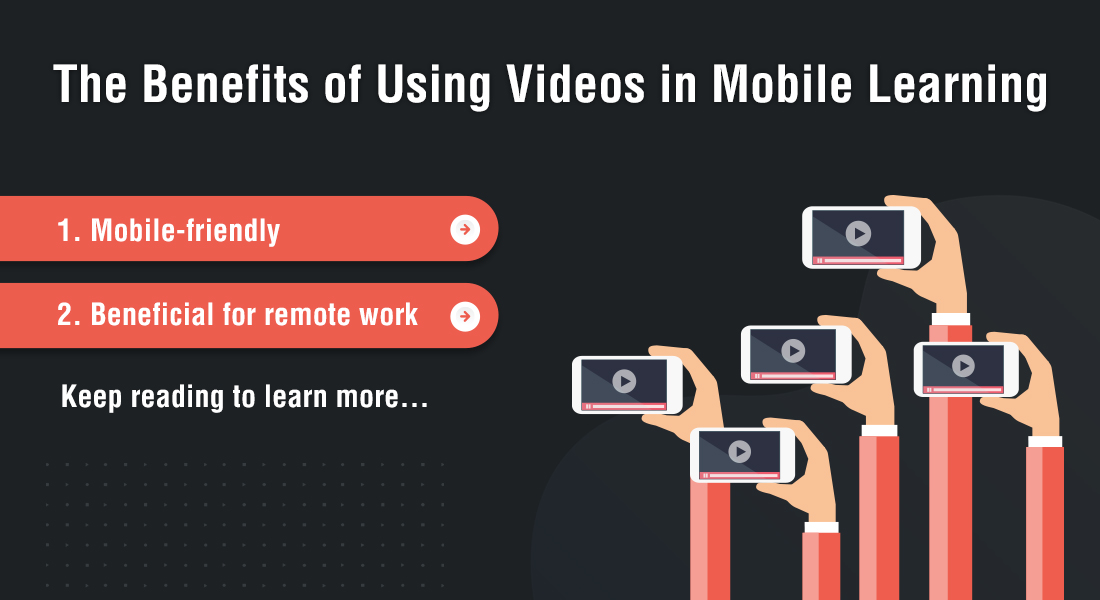5 Key Merits of Mobile Learning That Can Scale Your Corporate Training

Nowadays, we won’t leave our smartphones for even a minute, would you? Smartphones can be used for a variety of essential activities such as communicating, shopping, playing, or learning. Yes, you read it right, learning, mobile learning is one of the most significantly evolving trends in the eLearning industry. Corporate training looks vague if they don’t embed mobile learning within their training modules. Apparently, no one would prefer to get up and attend lengthy learning sessions when they can stay where they are and access the information on their mobile devices instead, that too in a relatively shorter period. Let’s gain valuable insights into mobile learning in detail.
Wondering How Mobile Learning is Beneficial for the Corporate Workforce?
Here are the prime benefits of mobile learning:
- Responsive design that promotes Microlearning
- Self-paced learning
- Improved engagement and knowledge retention
- Social learning
- Cost-effective and easy redeployment
Read on to understand these benefits in detail.
What is Mobile Learning (mLearning)?
Learning on the go seamlessly through smartphones or tablets is basically what mobile learning means. The workplaces have changed drastically and being able to engage the remote workforce with equally efficient training sessions is a challenge in itself. Mobile learning successfully overcomes this challenge due to its dynamic nature. Any sort of learning or training sessions can be conducted on mobile devices whether they are formal, informal, instant, self-paced, or social learning programs. This immense versatility has helped mLearning to secure its place deep within the eLearning industry.
Why is Mobile Learning Significant in The Modern Corporate World?
As we all know about the Covid-19 pandemic and how atrocious everything looked when it all started. But, if the industries didn’t adapt to the situation, things would have been totally different from what they are right now. Mobiles and the internet were the combined saviors for the industries across the globe affected by the pandemic. This whole “work from home” culture, made mobile learning more of a necessity than a choice. Learners adapting to eLearning preferred short videos, creative infographics, podcasts, etc and due to the fact that all of these were an integral part of mobile learning, helped it gain significance in the corporate world.
What Are The 5 Prime Benefits of Mobile Learning?
1. Responsive design that promotes Microlearning
One of the most important features of mobile learning is that the content that is made for mobiles is responsive. This means it can adapt to any screen size and eventually look equally engaging with all its accessible features on multiple devices and hence greatly support the most basic “learning on the go” narrative of mobile learning. Microlearning content such as short videos is best suited for mobiles and thus mobile learning makes it super-easy for microlearning content to be consumed.
Find out where does microlearning fit in your learning strategy?
2. Self-paced learning
Training managers are aware of the fact that not every employee learns at the same pace and hence they promote the method of mobile learning more than anyone else. Mobile learning allows the learners to consume the content at their own pace, from wherever they want, whenever they want, on whatever device they own (the device has to be a smartphone though).
3. Improved engagement and knowledge retention
In today’s modern world, it’s a proven fact that everyone is invested more in their smartphones than anything else. Any piece of information or content that is accessible on mobiles engages more users, same goes with eLearning courses. When employees can access the training sessions on their mobile devices, the completion rate of courses increases. Connecting the dots, when employees are more engaged, more employees complete the courses handed over to them in less time, eventually retaining most of the knowledge they gained throughout the course.
4. Social learning
Apart from enabling the employees to learn on the go, mobile learning promotes employees to learn along with each other. They can either be in touch with other employees and learn things together, ask their virtual instructors for doubts or even be a part of an active community of learners on the internet. Organizations often have specialized mobile apps to promote social learning and collaborations among employees. A handful of events such as a podcast can also be held through these mobile apps where training managers can either collaborate with the trainees or other training managers effectively.
5. Cost-effective and easy redeployment
The most obvious benefit of mobile learning is that it requires way less development and deployment cost than other training courses. Using modern authoring tools to create engaging mobile learning content will save a lot of fortune and it’s always easy to reuse, modify and redeploy the courses with their revised versions, improving the ROI for companies to a great extent.
What Are The 3 Possible Disadvantages of Mobile Learning?
1. Distraction
The biggest drawback of mobile learning is the potential distraction infused with its countless benefits. Anyone can get distracted in between their training sessions due to the specific ads, social media notifications, extremely addicting video games, and other pop-ups randomly showing up on the screen. The secret to overcoming this distraction lies totally within the user and their respective determination to learn and discipline toward their work.
2. Demands continuous electricity supply and internet access
There are still a lot of rural places where basic modern necessities such as electricity and internet access aren’t prevalent. Yes, this is not entirely relevant to the context, but this is still a fact and cannot be overlooked.
3. Technological compatibility barriers
This issue is highly specific and can only occur due to adopting careless development strategies. Developing courses according to the latest mobile technologies can often cause issues for people with relatively older devices that operate with older versions of operating systems or do not support some of the latest technology embedded along with the course. It is always advised to deploy content that is universally accessible for a lot of older versions as well.
Parting Thoughts!
Mobile learning has been a blessing for everyone who likes to sit back on their couches and learn things at their own pace. Even Google has started to give preference to mobile webpages over desktop webpages, so it is a clear sign that mobile learning is literally the future of eLearning. Mobile learning is something that should not be ignored at all and if you are planning to implement mobile learning into your eLearning sessions, here’s a free e-book that will make mobile learning a successful part of your training strategy.




![5 Reasons Mobile Learning is the Need of the Hour [SlideShare]](https://blog.commlabindia.com/hubfs/Imported_Blog_Media/mobile-learning-use-corporate-training-reasons-slideshare.jpg)
